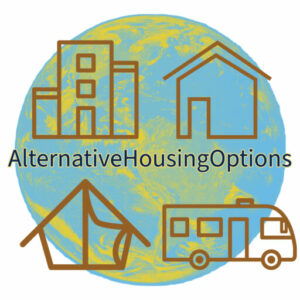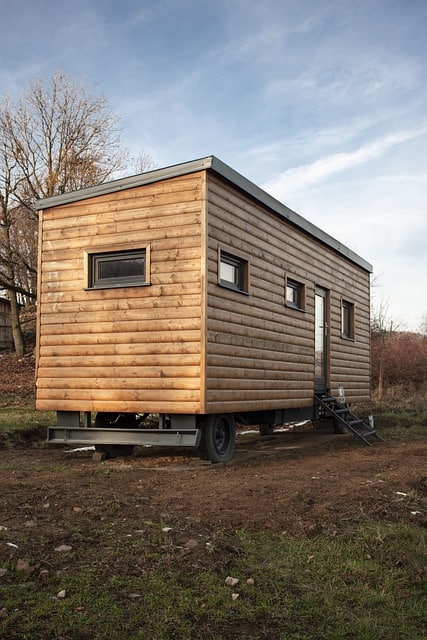Living in a tiny house is more than just a passing trend. The tiny house movement is a lifestyle choice that people make to save money, travel, and live simply. This movement has been around since 1998 and has only gained steam in the past five years during the perfect storm of rising housing prices and advertising through popular TV shows and podcasts.

What is a tiny house?
According to the real estate definition, a housing unit less than 500 sq. ft. of floor space, excluding lofts, is a tiny house. Most tiny houses people have built range between 100-400 square feet.
What is the point of tiny houses?
There are three main principles that tiny houses fulfill.
- Tiny houses are less expensive to build and maintain than a traditional stick-built home. You can have a tiny house built for you by a professional company for $50,000–70,000. Or DIY a tiny for $4,000–10,000 with the average being around $13,000.
- A tiny house can provide mobility when built on a trailer or skid and yield a reduced environmental impact. You can also permanently plant a tiny on a foundation slab. Giving tiny house owners a freedom they may not have had before.
- Many of those who live in tiny houses are concerned about the environment and their impact. Tiny homes are designed with an effective use of space. Tiny house owners may also want to save money, travel, or own a home without a mortgage.
How long do tiny homes last?
A tiny home can last 30-50 years, depending on how well the owners maintain the home. The materials used to build the home and the construction quality of the build will affect the home’s longevity. Due to more shifting, tiny homes on wheels break down faster than those on a foundation.
Why you shouldn’t buy a tiny house?
A tiny house is technically not considered real estate. It is a vehicle like a mobile home, RV, car, or truck. Any actual real estate involved will be if you own the lot where you park your tiny house. Like most vehicles, a tiny house will depreciate over time, while physical real estate like a traditional house typically appreciates.
What are the negative features of a tiny house? Here are five to consider.

- Lack of Living Space. This is obvious as the name does mean very small, but there might be features you didn’t realize when considering a tiny house. There is no room for a full-size bathroom or large kitchen. The living space is multi-purposed for entertaining, dining, and in some tiny homes—sleeping. The small space can make a tiny uncomfortable if more than two people live there.
- Lack of Storage. One of the main themes in owning a tiny house is owning less. This can mean significant downsizing and keeping only the belongings that are useful and necessary: goodbye trophy collection and hundreds of fishing poles and shoes. Donating the children’s toys or paring down to the most basic exercise equipment is a necessity for families.
- Limited Entertaining space. Gone are the large dinner parties and Thanksgiving meals. Unless you have a tiny in an area where you can expand to the outdoors by adding a deck or a patio, in a tiny house, you may not be hosting large gatherings.
- Zoning Rules. Many towns have a negative view of tiny homes. House zoning laws often have a minimum size required for the house built on the land. Tiny houses between 100-400 square feet do not meet the minimum. In this capacity, a tiny house is considered a vehicle or shed. Some tiny homeowners ask to park in a friend or family member’s backyard or next to their cabin. You can apply to a mobile home park if you’re looking for permanent placement.
- Financing. Tiny homes are not considered real estate, and as such, it can be hard or almost impossible to get a standard mortgage. Most tiny home builders and owners will need cash to build and park their tiny homes. Some tiny house buyers can finance their houses with personal loans from a private finance company.
What are the benefits of a tiny house? Here are seven of them.

- Lower Expenses. In a tiny house, everything costs less. It’s less to build, less in taxes and mortgage, and less to heat and cool. You can also travel, which may not cost as much as an RV or other travel vehicle.
- No Mortgage. We’ve discussed that financing can be challenging, so people either pay cash, get a personal loan, or borrow money from a friend or family member. A tiny homeowner has no mortgage when those financing options are paid back.
- Lower Energy Use. Tiny houses are cheaper to maintain. The bills for the major utilities are also less as owners are not heating, cooling, running electricity, or gas to a 2000 square foot house. A tiny house can run off of solar panels, wood stoves, and rainwater collection to create an off-grid system to make it even more cost-effective. A composting toilet can even eliminate the need for sewer.
- Freedom. A tiny homeowner has the option of boondocking if they want to travel and see the sights or move into a more permanent location in a mobile home park. A tiny house built on a trailer or skid gives owners the option of traveling wherever they can find a parking spot.
- Easier Maintenance. A tiny house has less space to clean inside and out and fewer appliances.
- Smaller Footprint. Tiny houses are great for people who want to have as little an impact as possible on the environment, especially with off-grid systems.
- Simple life. The lifestyle of the tiny house owner is minimalist. With the lack of space, the opportunity to own more than needed is not available.
What does a tiny home cost?
A tiny home costs so much less than a traditional home. Once you’ve purchased your tiny home, currently between $10,000–40,000, the upkeep can be relatively low. To have one professionally built can range between $50,000–70,000. You may need to buy land or pay to rent a lot, and you will need insurance for your tiny house, but your cost is much less than a traditional home.
What do tiny home designers focus on when building?
Design can have a big impact on your lifestyle. Imagine cabinets that opened the wrong way or your bathroom door swinging out into where people will be walking. Poor design is an accident waiting to happen, and on top of that, a bad layout can affect your mood. In the book Tiny Houses Built With Recycled Materials by Ryan Mitchell, tiny house designers ask five main questions before starting the design.
5 Questions to ask before designing a tiny house
- How will the design impact how the owner interacts with the space?
- How do the placement and design of the storage, seating, and windows affect the space?
- Does the storage hide clutter and promote a stress-free environment?
- Do the windows extend the line of sight and make the home feel larger?
- Do the materials in the build provide a warm and comfortable feeling?
No matter how beautiful the tiny home becomes, it won’t feel like a comfortable space if one or many of these are off.
Why is the tiny home trend becoming so popular?
Eight shows are streaming online from Disney+, Netflix, Hulu, YouTube, Discovery Channel. The popularity of these programs and the rising real estate prices have created an environment where living in a tiny house is very attractive.
If you’re more into the DIY version of a tiny house, check out the – Tiny House Made Easy – How to Build a Tiny House the Easy Way
The Tumbleweed Tiny House Company is a leading builder of tiny houses in the United States. If you want more information about having a tiny house built for you, visit their website. https://www.tumbleweedhouses.com/
What states allow tiny houses?
Before you start building your tiny house, check with your local building department on the legality of your building. Housing laws, zoning, and building regulations have to be tight to keep people safe.
Zoning laws explain where you can build or park a mobile dwelling. Many states have not yet developed specific building and zoning laws for tiny houses. Many states refer to Appendix Q of the International Residential Code, which was approved for inclusion in 2018. To see your state’s laws, search “state zoning laws” or “state building laws.”
Some states are more tiny-house friendly than others; however, remember that just because they are friendly, you’ll need to comply with the local building laws.
- California
- Colorado
- Florida
- Georgia
- Hawaii
- Idaho
- Maine
- Montana
- New Hampshire
- New York
- North Carolina
- South Carolina
- Oregon
- Virginia
- Washington
There are also states where building a tiny house is impossible under their current laws. These states are North Dakota, Iowa, Ohio, and West Virginia. Again, check with your local building and zoning department to see if they have guidelines you can follow.
Check out our other articles about different types of alternative housing ideas.
Tiny houses are less expensive to build and maintain than a traditional stick-built home. You can have a tiny house built for you by a professional company for $50,000–70,000. Or DIY a tiny for $4,000–10,000. A tiny house can provide mobility when built on a trailer or skid and yield a reduced environmental impact. You can also permanently plant a tiny on a foundation slab. Many of those who live in tiny houses are concerned about the environment and their impact. They may also want to save money, travel, or own a home without a mortgage.


